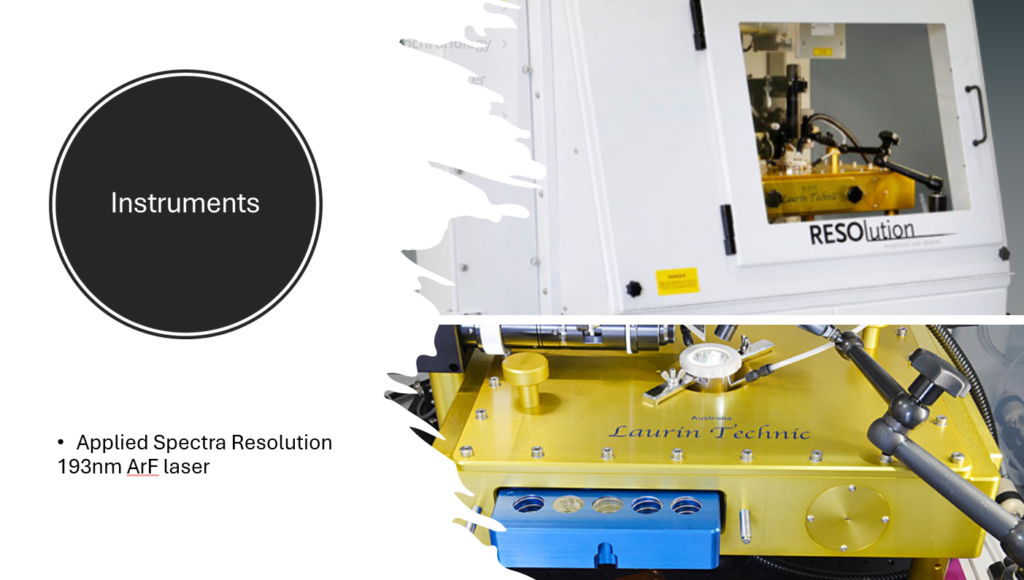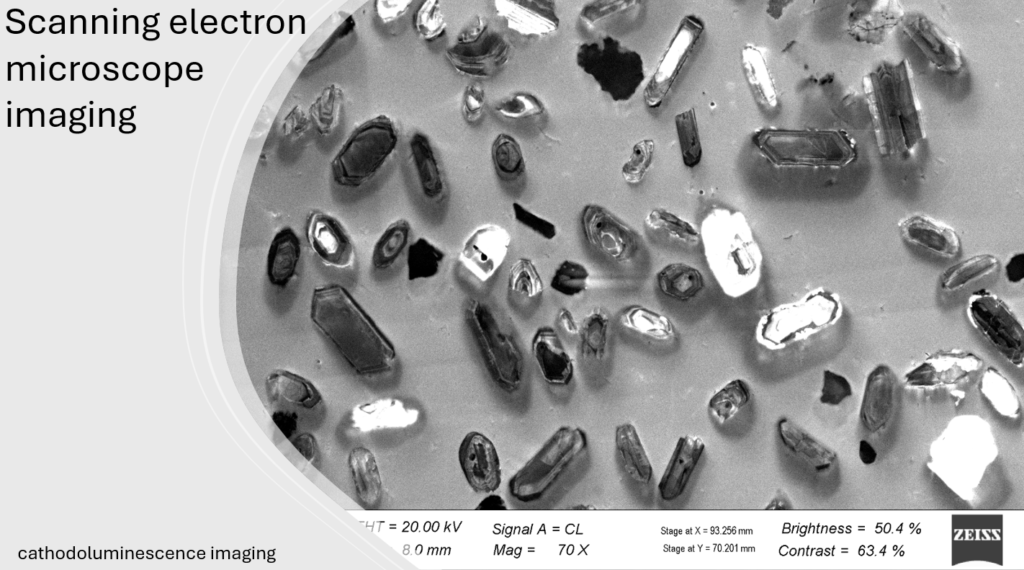LA-ICP-MS AGILENT 8800

Laser ablation inductively coupled plasma mass spectrometry (LA-ICP-MS) combined with an Agilent 8800 triple quadrupole ICP-MS is a powerful analytical technique for U-Pb geochronology and trace element analysis of minerals like zircon, monazite, apatite, and titanite. This method is widely used in geochronology because it enables in situ measurements, which preserve the spatial relationships and context of geological samples.
Key Components:
Laser Ablation System:

- A laser ablation system is used to vaporize a tiny portion of the mineral sample, creating an aerosol that is transported into the ICP-MS.
- The laser, a 193 nm ArF excimer, is focused on the mineral surface to produce fine ablation pits, often in the range of 10-40 micrometers in diameter.
- Spot size, laser fluence, and repetition rate are adjustable to optimize the ablation for different minerals, considering their hardness and matrix effects.
_______________________________________________________________________________________________________

________________________________________________________________________________________________________
Agilent 8800 Triple Quadrupole ICP-MS
The Agilent 8800 is a triple quadrupole (ICP-QQQ) mass spectrometer, which means it has two quadrupole mass filters separated by a collision/reaction cell. This configuration allows for effective interference removal by using reactive gases (e.g., O₂, NH₃, He) in the collision/reaction cell to eliminate isobaric interferences, like 204Hg on 204Pb.
The Agilent 8800 is known for its high sensitivity, low detection limits, and ability to handle complex matrices, making it ideal for trace element analyses and U-Pb isotopic measurements.

Applications
- Trace Element Analysis:
- The LA-ICP-MS method provides precise quantification of trace elements in minerals such as rare earth elements (REEs), high field strength elements (HFSEs), transition metals, and actinides.
- Trace element data in minerals like zircon, monazite, apatite, and titanite are critical for understanding geochemical processes, such as magma evolution, mineral growth conditions, and alteration histories.
- Elements like Y, Th, U, Pb, Sr, and REEs are particularly important for petrogenetic interpretations and geochemical fingerprinting of source rocks.
- U-Pb Geochronology:
- U-Pb dating relies on the radioactive decay of 238U to 206Pb and 235U to 207Pb. These decay systems are highly robust and provide accurate ages for minerals that incorporate U into their crystal lattice during formation.
- Zircon is the most common mineral used for U-Pb dating due to its high U content and ability to retain Pb during geological events, but monazite, apatite, and titanite are also valuable for dating metamorphic and igneous events.
- The Agilent 8800 allows for precise measurement of 206Pb/238U, 207Pb/235U, and 208Pb/232Th ratios, providing accurate age determinations.
- Ages can be calculated using Concordia diagrams or isochron plots, and corrections for common Pb can be applied based on measured 204Pb or other isotopic systems.
Advantages of LA-ICP-MS with Agilent 8800:
- In Situ Analysis: Allows for analyzing specific zones or domains within a mineral grain, preserving the geological context of each spot.
- High Spatial Resolution: Suitable for examining zoned minerals like zircon and monazite, which can contain growth rings or altered domains.
- Rapid Data Collection: Capable of analyzing large numbers of samples efficiently, making it ideal for surveys of detrital zircon populations or detailed studies of igneous and metamorphic rocks.
- Interference Removal: The triple quadrupole setup effectively reduces isobaric interferences, ensuring accurate isotopic ratio measurements, even in samples with complex matrices.
Applications in Geochronology and Geochemistry:

- Zircon U-Pb geochronology provides insights into the crystallization ages of magmatic rocks and metamorphic events, helping to constrain the thermal history of a region.
- Monazite dating is particularly useful for metamorphic terrains, as it can record multiple growth events related to prograde and retrograde metamorphism.
- Apatite can be used for thermochronology and detrital provenance studies, offering information about exhumation and sediment transport.
- Titanite is valuable for dating metamorphic and igneous processes, especially where zircon is absent or has been altered.
Overall, combining laser ablation with the Agilent 8800 allows researchers to perform detailed, high-precision analyses that are essential for unravelling the geological history recorded in U-bearing minerals. This technique has become a standard in the fields of isotope geochemistry, geochronology, and petrology, providing valuable data for reconstructing the timing and conditions of geological events.
